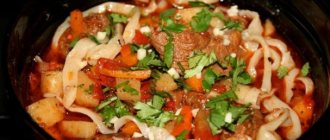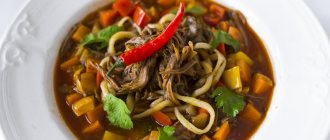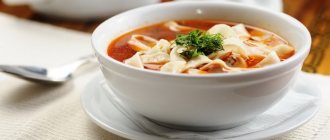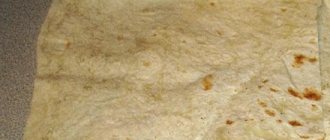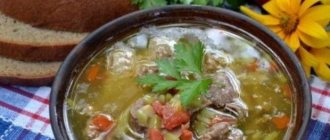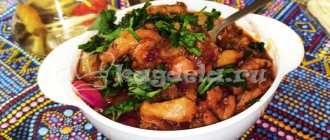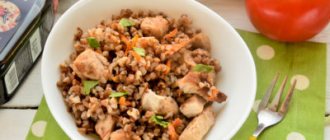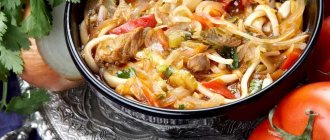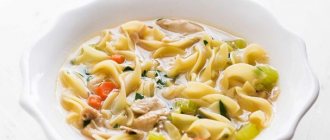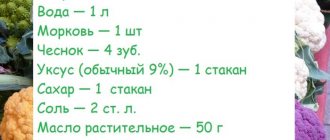Lagman is one of the national first dishes of Uyguria and Uzbekistan. Such a popular Central Asian dish is widespread in most post-Soviet countries. There are many recipes with a similar name, but the recipe for the Uzbek lagman is the most loved and has become a classic in the territory of the former Soviet Union. This is exactly what we will talk about.
Features of the Uzbek lagman
The main components of the traditional Uzbek lagman are noodles and vaja (thick sauce, soup). Noodles, as a rule, are prepared from unleavened dough, in two ways - stretched in the Uyghur way and cut in the Uzbek way.
To prepare Uyghur noodles, the dough is rolled out in the form of long ropes, wrapped around your hands, carefully pulled out, masterfully twisted and shaken in the air. It looks truly interesting and unusual. The noodles look like a thin thread of yarn. Professional chefs are able to fill a deep plate - kese with one long thread. The second method of preparing Uzbek noodles is much simpler. Roll out the dough into a layer and cut into thin strips.
Since lagman is a Central Asian dish, it involves the use of lamb meat and fat tail fat. However, each person’s taste preferences are different, so lamb can be replaced with beef, and fat tail fat can be replaced with melted butter. But absolutely any vegetables can be used. You can add beans, chickpeas, and peas to the dish. It is advisable to add vegetables and legumes in equal proportions. Lagman is difficult to classify as the first or second course. In its consistency, it resembles a thick soup, or a second with a generous amount of gravy.
Main types
The unique flavor of the food is determined by the representative of whose cuisine the lagman is. Not only the method of preparing and serving the dish, but also the list of components included in the composition largely depends on the country of origin.
Uigur
The brightest representative of his family. The classic recipe involves the use of lamb, green beans, eggplant, cabbage, radish and, of course, tomatoes or tomato paste.
Take note! If you want to cook a classic of the genre, forget about using potatoes: real Uyghur lagman is cooked without them.
Meat for Uyghur dishes is often pre-marinated. The noodles are made using the pulling method and boiled separately. A distinctive feature of the dish is a thick meat sauce with the addition of a large amount of pepper, garlic and spices (turmeric, cardamom, cumin).
Guyru lagman
Vegetables for its preparation are cut into elongated slices and fried in a deep thin-walled frying pan over high heat, which makes them slightly crispy. The recipe of the dish assumes maximum preservation of the appearance of vegetables - this is its highlight.
Tatar
One of the most exotic varieties, it is prepared using a fermented milk product - katyk. It is difficult to classify it as a purely Tatar dish: it is also popular among Bashkirs, Tajiks, and other Turkic peoples. The sauce for Tatar food is made from meat broth, a large number of different vegetables and spices, and only at the very end a little katyk is added, which makes its taste and aroma unique. Each family has its own special cooking recipe, but one thing remains unchanged - the dish is necessarily prepared on the basis of lamb or veal, and the noodles are pulled out by hand.
Uzbek
In Uzbekistan they prepare a dish that is fundamentally different from the classic Uyghur one. The difference lies in both the method of preparation and the manner of serving. Uzbek lagman, unlike Uyghur or Dungan, is a thick, rich soup cooked in a cauldron, and not in a deep frying pan.
The next characteristic feature of Uzbek food is the appearance of the noodles, which are cut into narrow strips rather than pulled into long ropes. The meat is also cut into small cubes, as are vegetables, among which you can rarely find radish or radish, so popular in the Uyghur recipe. The dish is served in deep ceramic plates, generously sprinkled with local herbs - cilantro, parsley, celery.
In Khorezmian
Despite the fact that Khorezm is located on the territory of modern Uzbekistan, the method of preparing local lagman has little in common with the traditional Uzbek one. The Khorezm dish has a second name - “shivit osh”, which translated means “dill soup”. As the name suggests, its recipe contains a large amount of dill, which not only gives it a peculiar piquancy, but also makes the dish very beautiful. Moreover, dill is not added to vegetables stewed with meat - waju, but directly to the noodle dough. Lagman is served in Khorezm style with a special white sauce based on a fermented milk drink with sour cream. Having tried this dish once, it is difficult to forget its unique taste, and most importantly, its unique appearance: festive, summer, bright.
Cooking noodles
First of all, you need to start preparing lagman with its base - noodles. The process of preparing noodles is divided into several stages:
- Preparing the dough
Half a kilogram of flour is sifted onto a wooden surface, creating a small mound. After making a small indentation at the top, carefully insert one egg. Holding the walls of the slide, gradually add, pre-mixed, half a teaspoon of salt with 1/8 cup of water.
Collecting flour from the bottom of the slide and pouring it into the recess, forcefully squeeze the flour and liquid. Knead the stiff dough for a long time and thoroughly. Roll the dough into a dense, homogeneous ball. The prepared mass is covered with a thick napkin and left to infuse for one hour.
- Rolling out the dough
Noodles are the main component of the Uzbek lagman, having a delicate consistency and giving the dish a special taste. To achieve thin, soft noodles, the dough must be very pliable. In this case, the dough is divided into small pieces, similar to a plum. Making small rolls out of them, the width of your palm, dip them in vegetable oil. Place in a bowl for 5-7 minutes. Then each roller is stretched by shaking and twisting movements. With this technique, the dough becomes plastic and durable, acquiring the desired shape.
- Boiling noodles
Noodles, like any other product made from hard dough, are boiled in well-salted and boiling water. After boiling, the noodles are placed in a colander and washed twice in cold water. Place it in a colander again to allow the water to drain, while simultaneously pouring a small amount of oil over it to prevent it from sticking together.
Preparing waji
It is vaja, as the main component of the dish, that creates the main taste and imbues the dish with a unique aroma. Uzbek vaja is prepared in a cauldron with thick walls. In European conditions, you can use a deep cast-iron frying pan or a roasting pan. To prepare you will need the following products:
- lamb pulp – 500 grams;
- lard or fat – 150-200 ml;
- half a head of garlic;
- 3 onions;
- 2 medium potatoes;
- 2 carrots;
- 2 bell peppers;
- 3-4 ripe tomatoes;
- spices and salt - to taste.
When cutting lamb meat, you should separate the fat and pulp from the bones. The lamb is cut into cubes and fried in hot lard or fat until a beautiful dark crust is formed. Then season with onions, cut into rings. When the onion acquires a golden hue, add carrots and potatoes, chopped into strips.
Next, season with ripe, peeled tomatoes and simmer until tender. When the tomatoes begin to release juice, add bell peppers, cut into half rings, into the vaja. Dried spices are poured into a cauldron - red pepper, cumin, paprika and coriander, salt is added and chopped garlic is seasoned. Adding a glass and a half of meat broth, simmer over low heat for 30 minutes.
By the time the waji is ready, the noodles will have cooled down a bit. To warm up the noodles, dip them in boiling water for a moment or, placing them in a colander, immerse them in boiling water for 1-2 minutes. After waiting for the excess water to drain, they begin to place the noodles in deep plates or bowls.
Uzbek lagman is formed from layers of noodles and gravy. Place a layer of noodles on the bottom of the dish, a layer of gravy on top, then another layer of noodles, then gravy. At the end, sprinkle with chopped cilantro and garlic.
Lagman with eggplants in European style
You can use the Uzbek lagman recipe as a basis. All vegetables to be placed in vaju are cut into small cubes or strips. In a cast-iron deep frying pan or cauldron, melt 70-90 grams of fat tail fat. 600 grams of lamb meat are fried in hot lard. Add fried onions and carrots to the meat (4 pieces each). Then add 5 tomatoes, 4 eggplants, 4 medium potatoes and 2 sweet peppers, pour water or broth over the vegetables. Add spices and salt to taste.
When the vaja starts to boil, reduce the heat and simmer for half an hour. It is advisable to add chopped garlic and herbs 5 minutes before readiness. To give the dish a special aroma, you can sprinkle the finished dish with cilantro, parsley or dill.
How best to cook lagman
Traditionally, lagman is prepared from lamb or beef, but many recipes use poultry, which makes this dish less fatty and high in calories.
The choice of vegetables and seasonings for lagman is huge and depends entirely on the imagination of the cook. Depending on the season, radishes, potatoes, eggplants, tomatoes, carrots, turnips, green beans, peas and other vegetables are added to it, which can be fried and stewed.
Like all oriental dishes, lagman is cooked in a large cast-iron cauldron over an open fire. However, at home it will turn out just as tasty and aromatic if you follow the recipe correctly. The cauldron can be replaced with a frying pan with high edges, and the lagman noodles can be replaced with spaghetti.
Option for beef lovers
Beef meat is perfect as a substitute for lamb. To prepare, take 350-400 grams of boneless meat, cutting into small cubes. Fry 2 onions, cut into half rings, in fat or melted butter. Then throw chopped vegetables into the cauldron - 3 carrots, half a radish and 4 sweet peppers.
Adding meat, fry until the meat forms a nice crust. Then season with 3 ripe tomatoes and 6-8 cloves of garlic. To stew meat and vegetables, add a liter of meat broth. After this, add 3 potatoes, reduce the heat, and simmer until tender. At the end, season the dish with spices and salt. When laying out the dish on plates, generously sprinkle the noodles with the prepared gravy with fresh herbs.
Classic lagman recipe
Ingredients:
- Meat - 0.5 kg
- potatoes - 6 pcs
- carrots - 4 pcs.
- tomatoes - 10 pcs
- bell pepper - 2 pcs
- cumin - 1 teaspoon
- bay leaf - 2 pcs
- ground red pepper - 1/2 teaspoon
- khmeli-suneli - 1 teaspoon
- salt - 1 teaspoon
Cooking method:
Place a cauldron or deep frying pan (preferably cast iron) on the stove, pour vegetable oil into it and wait for it to heat up, then lower the meat cut into small squares into it and add one teaspoon of salt, mix and cover with a lid for 15 minutes.
Peel and chop the onion, lower it to the meat, wait until all the liquid has evaporated, then cover with a lid and continue to simmer for another ten minutes.
It’s time for the carrots, peel them, cut them into small cubes and add them to the cauldron.
We do the same with potatoes.
Cover with a lid and cook for twenty minutes over medium heat.
We also cut the tomatoes and sweet bell peppers into small cubes and, after time, add them to the rest.
Fill with 1.5 liters of water so that the entire mass is hidden under it.
As soon as the liquid boils, add all the necessary spices, mix thoroughly, cover and simmer over low heat for 30 minutes.
In the meantime, while everything is being prepared, we prepare the garlic, and then put it through a press. Add to the dish and keep on fire for another 10 minutes. We take a tablespoon and check the broth for readiness; if it is rich, then everything is ready, if not, we continue to cook until it is completely cooked.
We cook pasta in the same way as in the photo.
Place the prepared spaghetti on a plate and spread the vegetable and meat sauce on top. The dish is ready, eat to your health.
